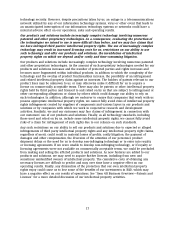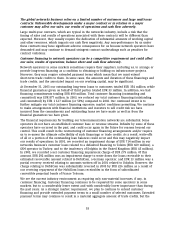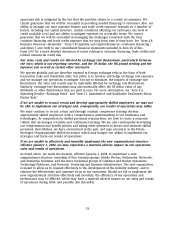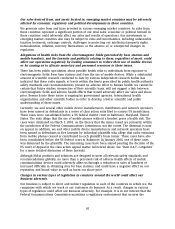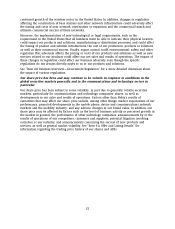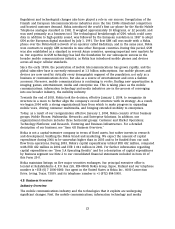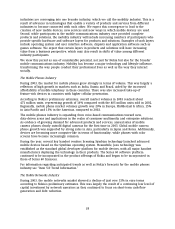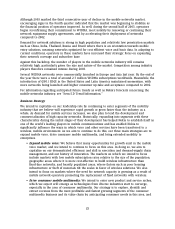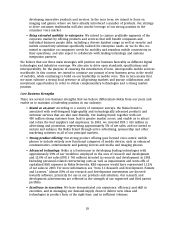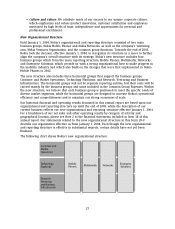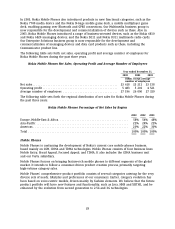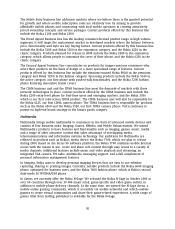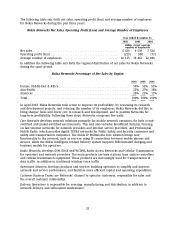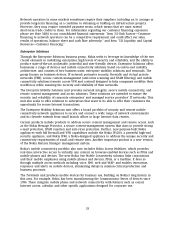Nokia 2003 Annual Report Download - page 25
Download and view the complete annual report
Please find page 25 of the 2003 Nokia annual report below. You can navigate through the pages in the report by either clicking on the pages listed below, or by using the keyword search tool below to find specific information within the annual report.industries are converging into one broader industry, which we call the mobility industry. This is a
result of advances in technologies that enable a variety of products and services from different
industries to become connected with each other. We expect this convergence to lead to the
creation of new mobile devices, new services and new ways in which mobile devices are used.
Second, while participants in the mobile communications industry once provided complete
products and solutions, the mobility industry will include increasing numbers of participants who
provide specific hardware and software layers for products and solutions. Examples of such layers
include operating system and user interface software, chipsets and application software such as
games software. We expect that certain layers in products and solutions will have increasing
value from a business perspective, which may also result in shifts of value among different
industry participants.
We view this period as one of considerable potential, not just for Nokia but also for the broader
mobile communications industry. Mobility has become a major technology and lifestyle influence,
transforming the way people conduct their professional lives as well as the way they interact
socially.
The Mobile Phones Industry
During 2003, the market for mobile phones grew strongly in terms of volume. This was largely a
reflection of high growth in markets such as India, Russia and Brazil, aided by the increased
affordability of mobile telephony in these countries. There was also increased take-up of
feature-rich devices in countries with higher cellular penetration.
According to Nokia’s preliminary estimates, overall market volumes in 2003 reached about
471 million units, representing growth of 16% compared with the 405 million units sold in 2002.
Regionally, mobile phone market volumes growth was 20% in Europe, Middle-East & Africa, 15%
in Asia-Pacific and 13% in the Americas, compared to 2002.
The mobile phones industry is expanding from voice-based communications toward new,
data-driven areas and applications in the realm of consumer multimedia and enterprise solutions.
As evidence of growing demand for advanced products and services, annual sales of mobile
camera phones clearly outsold digital cameras for the first time in 2003. Global mobile camera
phone growth was supported by strong sales in Asia, particularly in Japan and Korea. Additionally,
devices are becoming more computer-like in terms of functionality, while phones with color
screens have become increasingly common.
During the year, several key handset vendors licensing Symbian technology launched advanced
mobile devices based on the Symbian operating system. Meanwhile, Java technology was
established as the standard global developer platform for mobile devices, with all major handset
manufacturers deploying the technology in their products. The Series 60 software platform
continued to be incorporated in the product offerings of Nokia and began to be incorporated in
those of Series 60 licensees.
For information regarding anticipated trends as well as Nokia’s forecasts for the mobile phones
industry see ‘‘Item 5.D Trend Information.’’
The Mobile Networks Industry
During 2003, the mobile networks market showed a decline of just over 15% in euro terms
according to Nokia’s preliminary estimates. This was largely the result of a continuing low level of
capital investment by network operators as they continued to focus on short-term cash-flow
generation and debt reduction.
24





